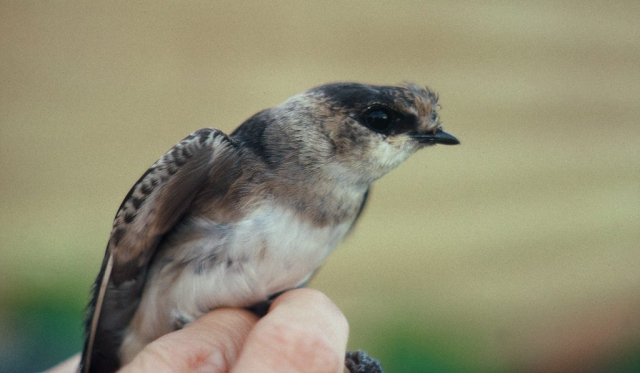Petrochelidon fulva pallida
Status: Rare casual summer visitor west-central.
Documentation: Photograph: 31 May 1991 Ash Hollow, Garden Co (Brown and Brown 1992, Brogie 1998).
Taxonomy: Six subspecies are recognized (AviList 2025), three in the Caribbean, one in Mexico, one, pallida, from south-central USA to north-central Mexico, and one, cavicola of Cuba, breeding in Florida since 1986.
Strickler and West (2020) merged cavicola with fulva, contra AviList (2025), which retains fulva with its range as Hispaniola.
The Nebraska record cited above was identified from the included photograph as subspecies pelodoma (=pallida, Phillips 1986), the subspecies breeding in New Mexico and Texas.
Summer: There are six accepted records, all from Keith Co and extreme southeast Garden Co, including four juveniles and two adults:
13 May 2004, adult Lake McConaughy, Keith Co (Silcock 2004)
31 May 1991, juvenile southeast Garden Co (cited above)
25-26 Jun 1995, juvenile Keith Co (Brogie 1998)
1 Jul 1998, juvenile Keith Co (Brown and Brown 2001)
8 Jul 2003, juvenile Keith Co (Silcock 2003)
24 Aug 2013, adult Lake Ogallala, Keith Co (Silcock 2013).
The juvenile netted 31 May 1991 at a concrete culvert about 4 miles south of highway 92 on highway 26 in extreme southeast Garden Co (cited above) was photographed and released later that day (Brown and Brown 1992) at Keystone Lake, Keith Co (Rosche 1994). The authors suggested that this bird was hatched in central Texas in early spring 1991 (nesting begins in Texas in Mar) and moved north with migrating Cliff Swallows. Another juvenile was captured 26 Jun 1995 east of Lake Ogallala (Brogie 1998); Brown et al (1996) stated that this bird was captured 6.5 miles east of Cedar Point Biological Station along the Sutherland Canal. A third juvenile was netted at Keystone, Keith Co 1 Jul 1998; Brown hypothesized that it also was hatched in Texas and came north with Cliff Swallows (Brown and Brown 2001). A fourth juvenile was netted just north of Lake Ogallala 8 Jul 2003 (Silcock 2003). The adult cited above 13 May 2004 was observed with a large group of Cliff Swallows grounded by cold weather (Silcock 2004); this bird apparently came north with migrating Cliff Swallows.
Comments: Identification of adult Cave Swallows is fairly straightforward; however, the range of variation among the thousands of juvenile Cliff Swallows that occur in Nebraska in fall makes separation of juvenile Cave Swallow at that time of year difficult. A single bird in Lancaster Co 25 Aug 2015 of uncertain age with a capped appearance and pale buffy throat was identified as this species but the report was not accepted by NOURC as “lacking in details for approval” (Brogie 2016). An update on a “possible” juvenile Cave Swallow 26 May 2014 in Lancaster Co suggested that it was best left unidentified (Tony Leukering, personal communication); Mary Bomberger Brown (personal communication) believed it was probably an early-hatched southern juvenile Cliff Swallow that moved north with Nebraska Cliff Swallows, a similar provenance suggested for the four juvenile Cave Swallow records for Nebraska. A report of a Cave Swallow at Harvard WPA, Clay Co 20 Jul 2013 was not accepted by NOURC (Brogie 2014), although the timing of the sighting is plausible.
The first three records for Kansas were 14 Jul 2001 and 26 Jul 2001 at Cheyenne Bottoms, and 27 Sep 2001 in Finney Co; most of the now several Kansas records are presumed to result from post-breeding dispersal (Thompson et al 2011). There are now several records for Kansas, one well-documented at Prewitt Reservoir, northeast Colorado, 17 Jul 2013, and single records for Oct 2007 in Iowa and Nov 2019 in Wisconsin, but none for South Dakota (eBird.org, accessed Nov 2023).
Images
Abbreviations
NOURC: Nebraska Ornithologists’ Union Records Committee
WPA: Waterfowl Production Area (Federal)
Literature Cited
AviList Core Team, 2025. AviList: The Global Avian Checklist, v2025. https://doi.org/10.2173/avilist.v2025.
Brogie, M.A. 1998. 1997 (Ninth) Report of the NOU Records Committee. NBR 66: 147-159.
Brogie, M.A. 2014. 2013 (25th) Report of the NOU Records Committee. NBR 82: 131-146.
Brogie, M.A. 2016. 2015 (27th) Report of the NOU Records Committee. NBR 84: 138-150.
Brown, C.R., and M.B. Brown. 1992. First Record of the Cave Swallow for Nebraska. NBR 60: 36-40.
Brown, C.R., and M.B. Brown. 2001. Birds of the Cedar Point Biological Station. Occasional Papers of the Cedar Point Biological Station, No. 1.
Brown, C.R., M.B. Brown, P.A. Johnsgard, J. Kren, and W.C. Scharf. 1996. Birds of the Cedar Point Biological Station area, Keith and Garden Counties, Nebraska: Seasonal occurrence and breeding data. Transactions of the Nebraska Academy of Sciences 23: 91-108.
Phillips, A.R. 1986. The known birds of North and Middle America. Part 1. Published by the author, Denver, Colorado, USA.
Rosche, R.C. 1994. Birds of the Lake McConaughy area and the North Platte River valley, Nebraska. Published by the author, Chadron, Nebraska, USA.
Silcock, W.R. 2003. Summer Field Report, June-July 2003. NBR 71: 106-127.
Silcock, W.R. 2004. Spring Field Report, March-May 2004. NBR 72: 38-58.
Silcock, W.R. 2013. Fall Field Report, August-November 2013. NBR 81: 134-160.
Strickler, S. and S. West. 2020. Cave Swallow (Petrochelidon fulva), version 1.0. In Birds of the World (A. F. Poole, Editor). Cornell Lab of Ornithology, Ithaca, NY, USA. https://doi.org/10.2173/bow.cavswa.01.
Thompson, M.C., C.A. Ely, B. Gress, C. Otte, S.T. Patti, D. Seibel, and E.A. Young. 2011. Birds of Kansas. University Press of Kansas, Lawrence, Kansas, USA.
Recommended Citation
Silcock, W.R., and J.G. Jorgensen. 2025. Cave Swallow (Petrochelidon fulva). In Birds of Nebraska — Online. www.BirdsofNebraska.org
Birds of Nebraska – Online
Updated 19 Jul 2025

